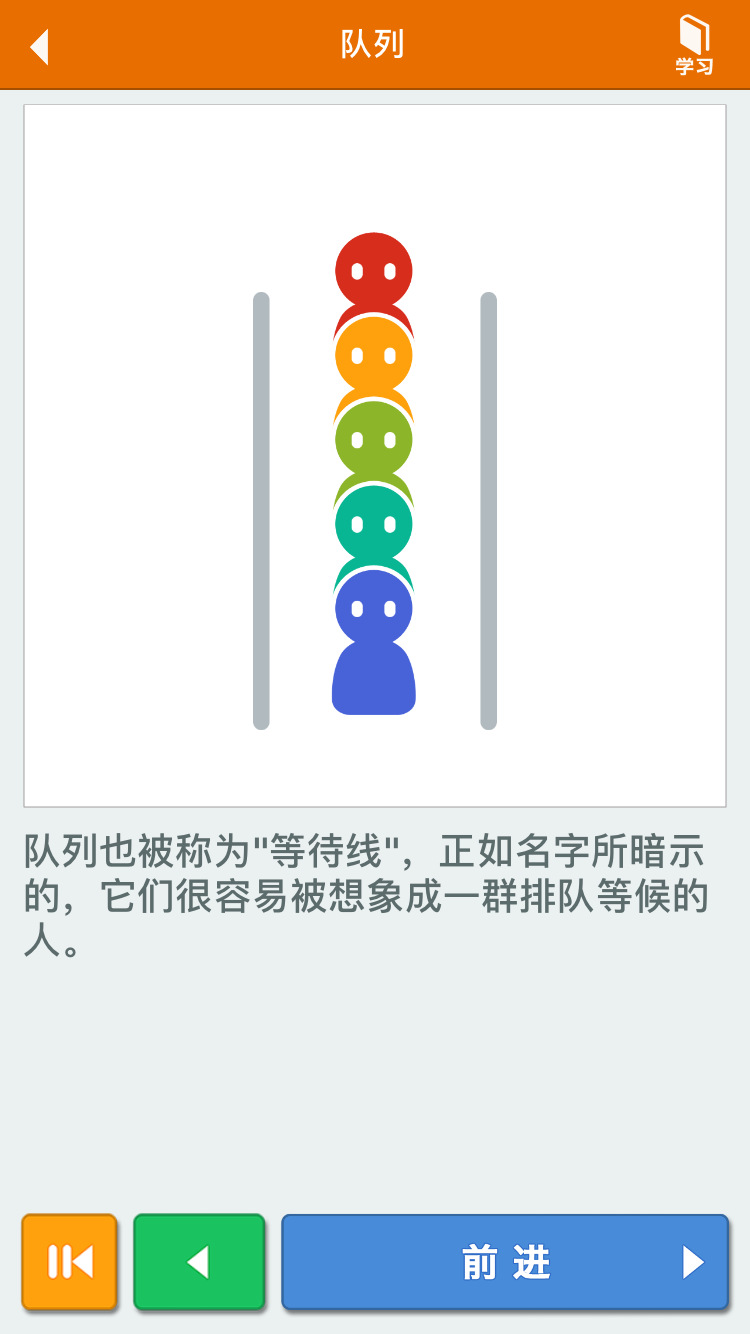什么是队列
队列是一种数据结构,队列也被称为”等待线”,正如名字所暗示的,他们很容易被想象成一群排队等待的人。排队时,排队越早,优先级越高。将数据添加到队列时,数据放在最后。从队列中取出数据时,将从最早添加的数据开始取出。从队列中取出数据的操作称为”出队”。队列是遵循先进先出(FIFO,也称为先来先服务)原则的一组有序的项。队列在尾部添加新元素,并从顶部移除元素。最新添加的元素必须排在队列的末尾。
现实中队列:排队、打印机的打印队列

队列
代码实现
1
2
3
4
5
6
7
8
9
10
11
12
13
14
15
16
17
18
19
20
21
22
23
24
25
26
27
28
29
30
31
32
33
34
35
36
37
38
39
40
41
42
43
44
45
46
47
48
49
50
51
52
53
54
55
56
57
58
59
60
61
62
63
64
65
66
67
68
69
70
71
72
73
74
75
76
77
78
79
80
81
82
83
84
85
|
export class Queue {
constructor() {
this.count = 0;
this.lowestCount = 0;
this.items = {};
}
enqueue(element) {
this.items[this.count] = element;
this.count++;
}
dequeue() {
if (this.isEmpty()) {
return undefined;
}
const result = this.items[this.lowestCount];
delete this.items[this.lowestCount];
this.lowestCount++;
return result;
}
peek() {
if (this.isEmpty()) {
return undefined;
}
return this.items[this.lowestCount];
}
isEmpty() {
return this.size() === 0;
}
clear() {
this.items = {};
this.count = 0;
this.lowestCount = 0;
}
size() {
return this.count - this.lowestCount;
}
toString() {
if (this.isEmpty()) {
return '';
}
let objString = `${this.items[this.lowestCount]}`;
for (let i = this.lowestCount + 1; i < this.count; i++) {
objString = `${objString},${this.items[i]}`;
}
return objString;
}
}
|
双端队列
概念
双端队列(deque,或称 double-ended queue)是一种允许我们同时从前端和后端添加和移除元素的特殊队列。
生活中常见的双端队列
双端队列在现实生活中的例子有电影院、餐厅中排队的队伍等。举个例子,一个刚买了票的人如果只是还需要再问一些简单的信息,就可以直接回到队伍的头部。另外,在队伍末尾的人如果赶时间,他可以直接离开队伍。
在计算机科学中,双端队列的一个常见应用是存储一系列的撤销操作。每当用户在软件中进行了一个操作,该操作会被存在一个双端队列中(就像在一个栈里)。当用户点击撤销按钮时,该操作会被从双端队列中弹出,表示它被从后面移除了。在进行了预先定义的一定数量的操作后,
最先进行的操作会被从双端队列的前端移除。由于双端队列同时遵守了先进先出和后进先出原则,可以说它是把队列和栈相结合的一种数据结构。
代码实现
1
2
3
4
5
6
7
8
9
10
11
12
13
14
15
16
17
18
19
20
21
22
23
24
25
26
27
28
29
30
31
32
33
34
35
36
37
38
39
40
41
42
43
44
45
46
47
48
49
50
51
52
53
54
55
56
57
58
59
60
61
62
63
64
65
66
67
68
69
70
71
72
73
74
75
76
77
78
79
80
81
82
83
84
85
86
87
88
89
90
91
92
93
94
95
96
97
98
99
100
101
102
103
104
105
106
107
108
109
110
111
112
113
114
115
116
117
118
119
120
121
122
123
124
125
126
127
128
129
130
131
132
133
134
135
|
export class Deque {
constructor() {
this.count = 0;
this.lowestCount = 0;
this.items = {};
}
addFront(element) {
if (this.isEmpty()) {
this.addBack(element);
} else if (this.lowestCount > 0) {
this.lowestCount--;
this.items[this.lowestCount] = element;
} else {
for (let i = this.count; i > 0; i--) {
this.items[i] = this.items[i - 1];
}
this.count++;
this.items[0] = element;
}
}
addBack(element) {
this.items[this.count] = element;
this.count++;
}
removeFront() {
if (this.isEmpty()) {
return undefined;
}
const result = this.items[this.lowestCount];
delete this.items[this.lowestCount];
this.lowestCount++;
return result;
}
removeBack() {
if (this.isEmpty()) {
return undefined;
}
this.count--;
const result = this.items[this.count];
delete this.items[this.count];
return result;
}
peekFront() {
if (this.isEmpty()) {
return undefined;
}
return this.items[this.lowestCount];
}
peekBack() {
if (this.isEmpty()) {
return undefined;
}
return this.items[this.count - 1];
}
isEmpty() {
return this.size() === 0;
}
clear() {
this.items = {};
this.count = 0;
this.lowestCount = 0;
}
size() {
return this.count - this.lowestCount;
}
toString() {
if (this.isEmpty()) {
return '';
}
let objString = `${this.items[this.lowestCount]}`;
for (let i = this.lowestCount + 1; i < this.count; i++) {
objString = `${objString},${this.items[i]}`;
}
return objString;
}
}
|
